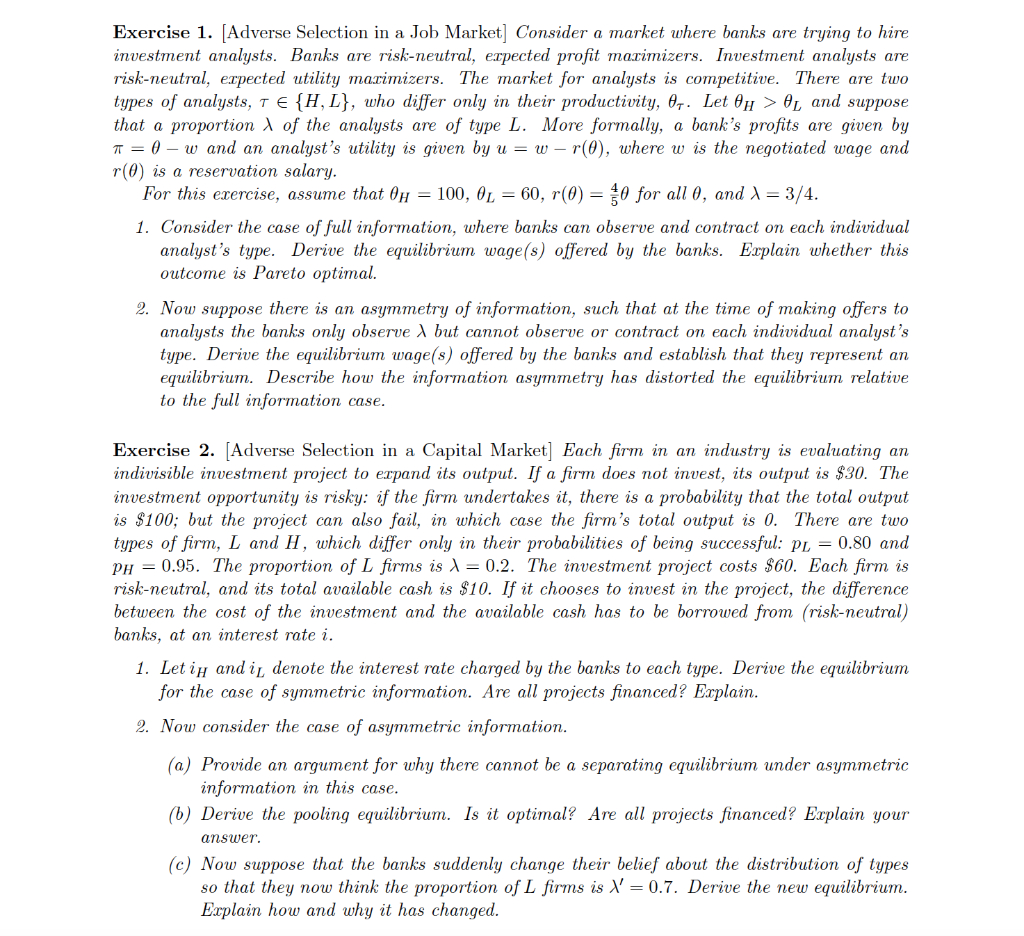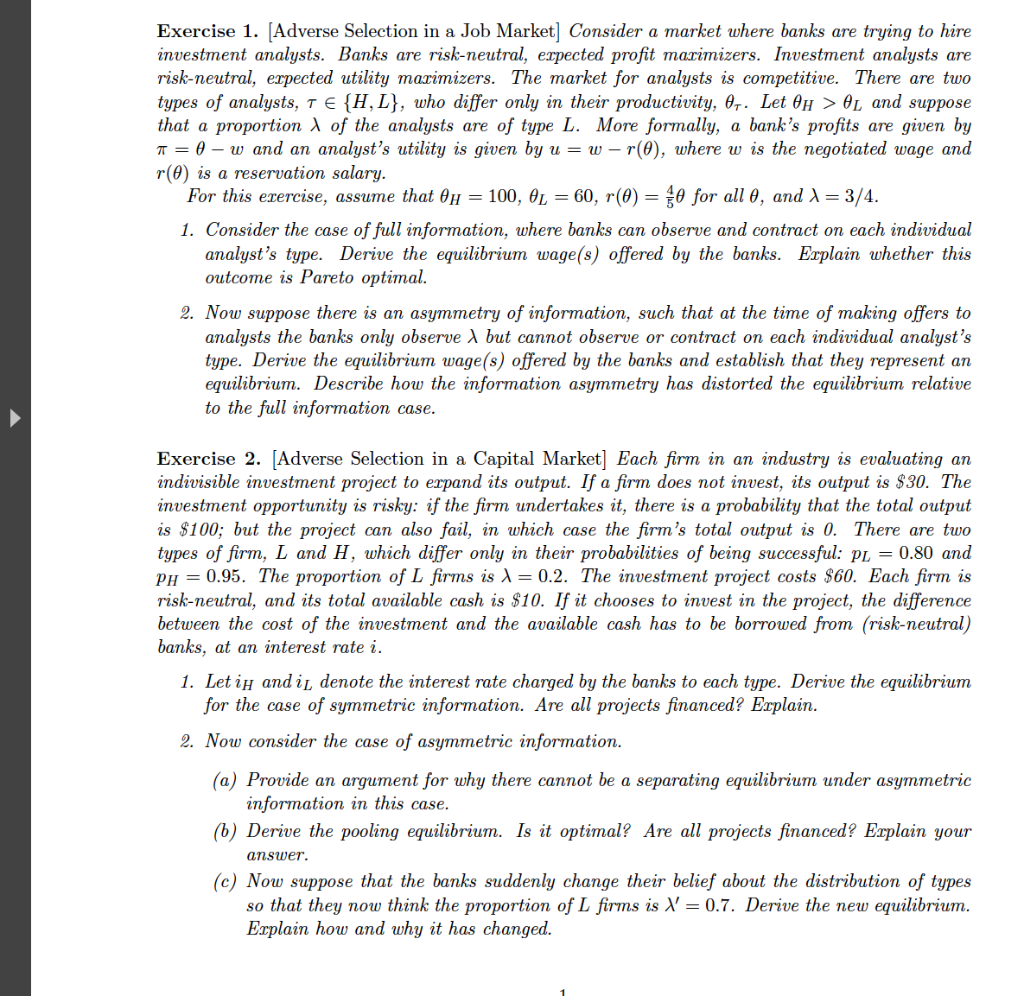

Exercise 1. (Adverse Selection in a Job Market] Consider a market where banks are trying to hire investment analysts. Banks are risk-neutral, erpected profit marimizers. Investment analysts are risk-neutral, expected utility marimizers. The market for analysts is competitive. There are two types of analysts, TE {H, L}, who differ only in their productivity, 07. Let ou > and suppose that a proportion of the analysts are of type L. More formally, a bank's profits are given by TI = 0 w and an analyst's utility is given by u = w r(@), where w is the negotiated wage and r(0) is a reservation salary. For this exercise, assume that Oh = 100, Q1 = 60, r(0) = 40 for all 0, and 1 = 3/4. 1. Consider the case of full information, where banks can observe and contract on each individual analyst's type. Derive the equilibrium wage(s) offered by the banks. Explain whether this outcome is Pareto optimal. 2. Now suppose there is an asymmetry of information, such that at the time of making offers to analysts the banks only observe but cannot observe or contract on each individual analyst's type. Derive the equilibrium wage(s) offered by the banks and establish that they represent an equilibrium. Describe how the information asymmetry has distorted the equilibrium relative to the full information case. Exercise 2. [Adverse Selection in a Capital Market] Each firm in an industry is evaluating an indivisible investment project to expand its output. If a firm does not invest, its output is $30. The investment opportunity is risky: if the firm undertakes it, there is a probability that the total output is $100; but the project can also fail, in which case the firm's total output is 0. There are two types of firm, L and H, which differ only in their probabilities of being successful: pl = 0.80 and ph = 0.95. The proportion of L firms is 1 = 0.2. The investment project costs $60. Each firm is risk-neutral, and its total available cash is $10. If it chooses to invest in the project, the difference between the cost of the investment and the available cash has to be borrowed from (risk-neutral) banks, at an interest rate i. 1. Let ih and i, denote the interest rate charged by the banks to each type. Derive the equilibrium for the case of symmetric information. Are all projects financed? Explain. 2. Now consider the case of asymmetric information. (a) Provide an argument for why there cannot be a separating equilibrium under asymmetric information in this case. (6) Derive the pooling equilibrium. Is it optimal? Are all projects financed? Explain your answer. (c) Now suppose that the banks suddenly change their belief about the distribution of types so that they now think the proportion of L firms is x = 0.7. Derive the new equilibrium. Explain how and why it has changed. Exercise 1. Adverse Selection in a Job Market] Consider a market where banks are trying to hire investment analysts. Banks are risk-neutral, expected profit maximizers. Investment analysts are risk-neutral, expected utility maximizers. The market for analysts is competitive. There are two types of analysts, TE {H, L}, who differ only in their productivity, 0,. Let Oh > OL and suppose that a proportion of the analysts are of type L. More formally, a bank's profits are given by T = 0 w and an analyst's utility is given by u = w - r(@), where w is the negotiated wage and r(@) is a reservation salary. For this erercise, assume that 0h = 100, OL = 60, r(0) = go for all , and = 3/4. 1. Consider the case of full information, where banks can observe and contract on each individual analyst's type. Derive the equilibrium wage(s) offered by the banks. Explain whether this outcome is Pareto optimal. 2. Now suppose there is an asymmetry of information, such that at the time of making offers to analysts the banks only observed but cannot observe or contract on each individual analyst's type. Derive the equilibrium wage(s) offered by the banks and establish that they represent an equilibrium. Describe how the information asymmetry has distorted the equilibrium relative to the full information case. Exercise 2. (Adverse Selection in a Capital Market] Each firm in an industry is evaluating an indivisible investment project to erpand its output. If a firm does not invest, its output is $30. The investment opportunity is risky: if the firm undertakes it, there is a probability that the total output is $100; but the project can also fail, in which case the firm's total output is 0. There are two types of firm, L and H, which differ only in their probabilities of being successful: pl = 0.80 and PH = 0.95. The proportion of L firms is 1 = 0.2. The investment project costs $60. Each firm is risk-neutral, and its total available cash is $10. If it chooses to invest in the project, the difference between the cost of the investment and the available cash has to be borrowed from (risk-neutral) banks, at an interest rate i. 1. Let ih and i denote the interest rate charged by the banks to each type. Derive the equilibrium for the case of symmetric information. Are all projects financed? Explain. 2. Now consider the case of asymmetric information. (a) Provide an argument for why there cannot be a separating equilibrium under asymmetric information in this case. (6) Derive the pooling equilibrium. Is it optimal? Are all projects financed? Erplain your answer. (c) Now suppose that the banks suddenly change their belief about the distribution of types so that they now think the proportion of L firms is = 0.7. Derive the new equilibrium. Explain how and why it has changed. Exercise 1. (Adverse Selection in a Job Market] Consider a market where banks are trying to hire investment analysts. Banks are risk-neutral, erpected profit marimizers. Investment analysts are risk-neutral, expected utility marimizers. The market for analysts is competitive. There are two types of analysts, TE {H, L}, who differ only in their productivity, 07. Let ou > and suppose that a proportion of the analysts are of type L. More formally, a bank's profits are given by TI = 0 w and an analyst's utility is given by u = w r(@), where w is the negotiated wage and r(0) is a reservation salary. For this exercise, assume that Oh = 100, Q1 = 60, r(0) = 40 for all 0, and 1 = 3/4. 1. Consider the case of full information, where banks can observe and contract on each individual analyst's type. Derive the equilibrium wage(s) offered by the banks. Explain whether this outcome is Pareto optimal. 2. Now suppose there is an asymmetry of information, such that at the time of making offers to analysts the banks only observe but cannot observe or contract on each individual analyst's type. Derive the equilibrium wage(s) offered by the banks and establish that they represent an equilibrium. Describe how the information asymmetry has distorted the equilibrium relative to the full information case. Exercise 2. [Adverse Selection in a Capital Market] Each firm in an industry is evaluating an indivisible investment project to expand its output. If a firm does not invest, its output is $30. The investment opportunity is risky: if the firm undertakes it, there is a probability that the total output is $100; but the project can also fail, in which case the firm's total output is 0. There are two types of firm, L and H, which differ only in their probabilities of being successful: pl = 0.80 and ph = 0.95. The proportion of L firms is 1 = 0.2. The investment project costs $60. Each firm is risk-neutral, and its total available cash is $10. If it chooses to invest in the project, the difference between the cost of the investment and the available cash has to be borrowed from (risk-neutral) banks, at an interest rate i. 1. Let ih and i, denote the interest rate charged by the banks to each type. Derive the equilibrium for the case of symmetric information. Are all projects financed? Explain. 2. Now consider the case of asymmetric information. (a) Provide an argument for why there cannot be a separating equilibrium under asymmetric information in this case. (6) Derive the pooling equilibrium. Is it optimal? Are all projects financed? Explain your answer. (c) Now suppose that the banks suddenly change their belief about the distribution of types so that they now think the proportion of L firms is x = 0.7. Derive the new equilibrium. Explain how and why it has changed. Exercise 1. Adverse Selection in a Job Market] Consider a market where banks are trying to hire investment analysts. Banks are risk-neutral, expected profit maximizers. Investment analysts are risk-neutral, expected utility maximizers. The market for analysts is competitive. There are two types of analysts, TE {H, L}, who differ only in their productivity, 0,. Let Oh > OL and suppose that a proportion of the analysts are of type L. More formally, a bank's profits are given by T = 0 w and an analyst's utility is given by u = w - r(@), where w is the negotiated wage and r(@) is a reservation salary. For this erercise, assume that 0h = 100, OL = 60, r(0) = go for all , and = 3/4. 1. Consider the case of full information, where banks can observe and contract on each individual analyst's type. Derive the equilibrium wage(s) offered by the banks. Explain whether this outcome is Pareto optimal. 2. Now suppose there is an asymmetry of information, such that at the time of making offers to analysts the banks only observed but cannot observe or contract on each individual analyst's type. Derive the equilibrium wage(s) offered by the banks and establish that they represent an equilibrium. Describe how the information asymmetry has distorted the equilibrium relative to the full information case. Exercise 2. (Adverse Selection in a Capital Market] Each firm in an industry is evaluating an indivisible investment project to erpand its output. If a firm does not invest, its output is $30. The investment opportunity is risky: if the firm undertakes it, there is a probability that the total output is $100; but the project can also fail, in which case the firm's total output is 0. There are two types of firm, L and H, which differ only in their probabilities of being successful: pl = 0.80 and PH = 0.95. The proportion of L firms is 1 = 0.2. The investment project costs $60. Each firm is risk-neutral, and its total available cash is $10. If it chooses to invest in the project, the difference between the cost of the investment and the available cash has to be borrowed from (risk-neutral) banks, at an interest rate i. 1. Let ih and i denote the interest rate charged by the banks to each type. Derive the equilibrium for the case of symmetric information. Are all projects financed? Explain. 2. Now consider the case of asymmetric information. (a) Provide an argument for why there cannot be a separating equilibrium under asymmetric information in this case. (6) Derive the pooling equilibrium. Is it optimal? Are all projects financed? Erplain your answer. (c) Now suppose that the banks suddenly change their belief about the distribution of types so that they now think the proportion of L firms is = 0.7. Derive the new equilibrium. Explain how and why it has changed








